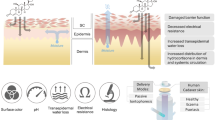Summary
Absolute concentrations in the horny layer, epidermis, and dermis of therapeutical doses of topically applied hydrocortisone to human skin (in vivo) are reported. Using vaseline as vehicle 2 ⋅ 10−4 molar concentrations are found in the epidermis and 3 ⋅ 10−5 molar concentrations in the dermis. Further, three vehicles revealed minor concentrations.
Comparison of the results with similar in vitro-investigations, reported earlier, allow to judge the resorption rate by the intact capillary system. Uptake of hydrocortisone by the vessels is observed. With high rates of penetration vasoconstriction seems to limit the resorption, while this is not the case with low rates, for instance with polyethyleneglycol as vehicle. Thus a differing drug liberation from the vehicle causes qualitatively different permeation kinetics. The elimination by urine, however, was practically the same. It is concluded that different vehicles may cause different therapeutic concentrations of the drug in the skin, but equal systemic side effects.
Zusammenfassung
Die Absolutkonzentrationen von Hydrocortison in Hornschicht, Epidermis und Corium nach therapieadäquater Lokalapplikation auf die menschliche Haut (in vivo) werden dargestellt. Es werden aus Vaseline als Vehikel 2 ⋅ 10−4 molare Konzentrationen in der Epidermis und 3 ⋅ 10−5 molare Konzentrationen im Corium erreicht. Drei weitere Vehikel ergaben geringere Konzentrationen.
Aus dem Vergleich der Ergebnisse mit gleichartigen in vitro-Untersuchungen, über die früher berichtet wurde, kann auf die Resorption durch das in vivo funktionsfähige Gefäßsystem geschlossen werden. Hydrocortison wird deutlich durch das Gefäßsystem abtransportiert. Es ergaben sich Hinweise dafür, daß bei hohen Penetrationsraten eine Vasoconstriction die Resorption begrenzt. Bei geringen Penetrationsraten, z. B. aus Polyäthylenglykol, fehlen diese Indizien. Unterschiedliche Freigaberaten aus den Vehikeln bewirken demnach qualitativ differente Permeationskinetiken. Die Harnausscheidung bleibt dagegen faktisch gleich. Hieraus ist zu schließen, daß verschiedene Vehikel zu unterschiedlichen Dosen des Pharmakons in der Haut bei gleicher systemischer Belastung führen können.
Similar content being viewed by others
References
Brode, E.: Die percutane Resorption von Corticosteroiden. Arzneimittel-Forsch. (Drug Res.)18, 448 (1968)
Feldmann, R. J., Maibach, H. I.: Penetration of14C-hydrocortisone through normal skin. The effect of stripping and occlusion. Arch. Derm.91, 661–666 (1965)
Feldmann, R. J., Maibach, H. I.: Absorption of some organic compounds through the skin in man. J. invest. Derm.54, 399–404 (1970)
Hsia, S. C., Mursallem, A. J., Witten, V. H.: Further metabolic studies of hydrocortisone-4-14C in human skin. J. invest. Derm.45, 384–388 (1965)
Katz, M., Poulsen, B. J.: Corticoid, vehicle and skin interaction in percutaneous absorption. J. Soc. cosmet. Chem.23, 565–590 (1972)
Kolb, K. H., Schulze, P. E.: Über die cutane Penetration von Sexualsteroidhormonen. Symp. Dtsch. Ges. Endokrin.17, 49–56 (1971)
Scoggins, T. R., Kliman, B.: Percutaneous absorption of corticosteroids. J. Med. (N. Engl.)273, 831 (1965)
Stüttgen, G., Krause, H.: Die percutane Absorption von tritiummarkiertem Pantheonol bei Mensch und Tier. Arch. klin. exp. Derm.209, 578–582 (1960)
Winkler, K.: Elimination und Resorption von markiertem Fluocortolon und Fluocortoloncapronat. Z. Haut- u. Geschl.-Kr.43, 247–253 (1968)
Wurster, D. E.: Some practical applications of percutaneous absorption theory, advances in biology of skin, vol. XII: Pharmacology and the skin, pp. 153–168. New York: Appleton-Century-Crofts 1972
Zesch, A., Schaefer, H.: Penetrationskinetik von radiomarkiertem Hydrocortison aus verschiedenen Salbengrundlagen in die menschliche Haut — in vitro. Arch. Derm. Forsch.246, 335–354 (1973)
Zesch, A., Schaefer, H.: Penetration kinetics of four drugs in the human skin. Acta derm.-venereol. (Stockh.)54, 91–98 (1974)
Author information
Authors and Affiliations
Rights and permissions
About this article
Cite this article
Zesch, A., Schaefer, H. Penetrationskinetik von radiomarkiertem hydrocortison aus verschiedenartigen salbengrundlagen in die menschliche haut II. In vivo. Arch. Derm. Res. 252, 245–256 (1975). https://doi.org/10.1007/BF00560364
Received:
Published:
Issue Date:
DOI: https://doi.org/10.1007/BF00560364




